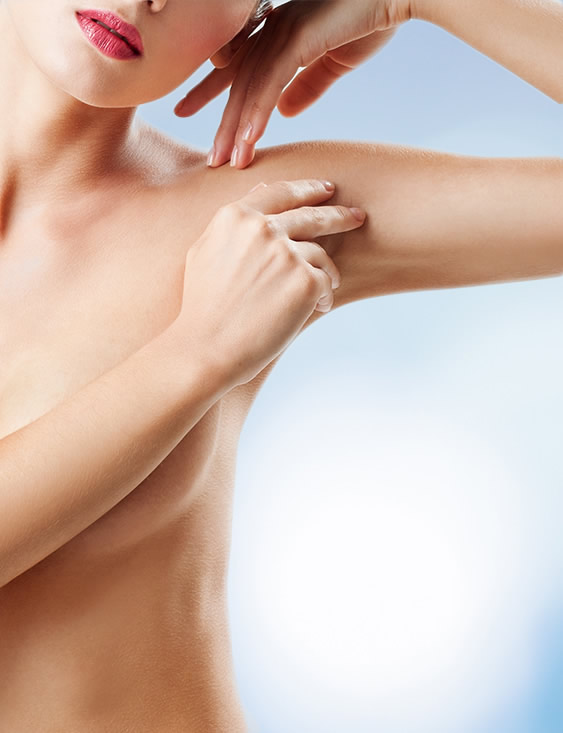
Hyperhidrosis
Sweating helps to cool the body’s temperature after physical exertion or exercise. It is a process that is your body’s natural response to exercise, warmer temperatures, or even feelings like fear, anxiety, or nerves, but when you sweat without any of the previously mentioned stimuli, it can be embarrassing and a nuisance. Hyperhidrosis and its symptoms can make you feel self-conscious and uncomfortable, especially when in public or social settings.
What is hyperhidrosis?
Hyperhidrosis is a condition where your sweat glands are overactive, which results in excessive perspiration or sweating. Excessive sweating is defined by a person experiencing periodic perspiration when there are no environmental or emotional factors prompting perspiration. A person with hyperhidrosis can experience sweating even when at rest in a cool, calm environment. Sweating is the natural response of the body to help it cool down, but if you are sweating when your body does not need to be cooled down, then you may be suffering from hyperhidrosis.
Sweating can interrupt daily life and cause much discomfort, embarrassment, and anxiety. Due to the constant presence of sweat on your skin that does not properly dry or ventilate, an infection can develop. These skin infections can arise because the sweat is continually being produced and then trapped by your clothing. Without proper ventilation, you may experience skin irritation, inflammation, acne, or an infection. There are two types of hyperhidrosis, which are called secondary hyperhidrosis and primary hyperhidrosis. If you experience hyperhidrosis as a symptom stemming from another medical condition, you may have secondary hyperhidrosis. When no underlying medical condition causes excessive sweating, you may have primary hyperhidrosis.
What hyperhidrosis tests are there?
To determine if you are suffering from hyperhidrosis and may benefit from a hyperhidrosis treatment, a hyperhidrosis test will be performed for you. To properly diagnose you and choose the best hyperhidrosis treatment, our dermatologists may ask you about triggers that cause a flare-up of your symptoms. Our dermatologists may ask about when, where, and how long you experience excessive sweating symptoms, as well as why your symptoms flare-up. To better understand your case, our dermatologist will ask what brings on an episode of excessive sweating, such as nerves or traumatic events. There are multiple hyperhidrosis tests, and some of the most popular include a starch-iodine test, blood test, and a sweat test.
In a starch-iodine test, an iodine solution will be applied to the areas that you most experience excessive sweating in. Once the iodine solution dries on your skin, a small amount of starch will be placed on the affected area. The chemical reaction causes the starch and iodine combination to turn a dark blue color where you are experiencing excessive sweating.
A blood test may be ordered if our dermatologists believe that your symptoms are due from other medical conditions or symptoms. If our dermatologists believes that your excessive sweating stems from other medical conditions like thyroid problems, diabetes, or endocarditis, then a blood test will help determine the cause of your symptoms, which will help you manage and treat your case effectively.
Sweat tests may be performed to determine the extent of your symptoms. Our dermatologists can monitor the amount, frequency, and severity of your excessive sweating through a sweat test. With the knowledge of your specific case and symptoms, our dermatologist can help create a treatment regimen to manage your symptoms.
| Common Hyperhidrosis Tests | |
| Starch-iodine Test | An iodine solution is applied to the affected area. After drying, starch is applied. The combination results in a dark blue coloring wherever you experience excessive sweating. |
| Blood Test | A blood test may be ordered if the cause of your symptoms is unclear. Can help rule out other medical conditions that may be causing excessive sweating. |
| Sweat Test | Sweat tests help to determine the extent and severity of your symptoms. We will be able to determine factors of your case that can help create a treatment regimen. |
What are hyperhidrosis symptoms?
The main symptom of hyperhidrosis is excessive sweating. If you are experiencing other symptoms accompanied with excessive sweating, a blood test may be ordered to rule out any other conditions that may be affecting you. If excessive sweating is caused by another underlying medical condition such as heart disease or menopause, then you may be experiencing secondary hyperhidrosis. On the other hand, primary hyperhidrosis is when your symptoms do not stem directly from another medical condition.
If you are experiencing primary hyperhidrosis, you may benefit from a hyperhidrosis treatment. If excessive sweating is not managed, you may be prone to bacterial or fungal skin infections. When sweat cannot properly ventilate due to clothing, it lingers on your skin and clogs your pores. When this happens frequently, infection and inflammation are prone to develop on your skin.
Those who suffer from hyperhidrosis are more prone to developing warts, body odor, jock itch, social anxiety, and athlete’s foot. On top of this, you may also experience skin maceration (disintegration), which results from the skin being continually moist due to sweating. Maceration can result in a soft, wet appearance of the skin, which can also lead to more skin conditions and complications.
What is a hyperhidrosis treatment like?
There are many hyperhidrosis treatments available, but our dermatologists will assess your symptoms and options to create the most effective hyperhidrosis treatment regimen. Common hyperhidrosis treatments include prescription-strength antiperspirants, oral medications, laser therapy, and BOTOX®.
An antiperspirant is specifically designed to reduce and prevent sweating. This hyperhidrosis treatment works by blocking the sweat glands, which prevents the sweat from being released and forming on your skin. A prescription antiperspirant is a stronger antiperspirant that usually contains aluminum chloride, which helps to cover and stop the sweat glands from producing sweat on the skin. Some prescription-strength antiperspirants can even help reduce the size of sweat glands.
A prescription oral medication may be suggested if excessive sweating persists after using an antiperspirant. Medication as a hyperhidrosis treatment helps to block the stimulation of sweat glands, which reduces and stops your sweat glands from creating sweat that appears on your skin. Oral medications can help limit sweat glands over your entire body.
Laser therapy as a hyperhidrosis treatment uses a strong, focused beam of light to help treat the affected area. This focused beam helps to target only the affected area that is being treated. The heat from the laser in a laser treatment helps to prevent the hyperactivity in your sweat glands. This hyperhidrosis treatment shows significant results after just a single session, and it is proven to reduce the excessive sweating of hyperhidrosis.
How can BOTOX® treat hyperhidrosis?
Botulinum toxin, known more readily as BOTOX®, injections for hyperhidrosis can help reduce the hyperactivity of sweat glands. A BOTOX® injection can block the nerves that send messages to the sweat glands. This blocking of communication prevents the sweat glands from overly producing sweat. It is an outpatient procedure with minimal to no downtime needed. BOTOX® temporarily blocks the nerves that stimulate the sweat glands, so the session must be repeated semi-annually or annually to maintain results. As your sessions continue, you will need BOTOX® injections less frequently to maintain and manage your hyperhidrosis symptoms.
| Common Hyperhidrosis Treatments | |
| Prescription Antiperspirants | Specifically designed to reduce and prevent sweating. Blocks the sweat glands to prevent sweat from reaching the surface of your skin. May help reduce size of sweat glands. |
| Oral Medication | Blocks the stimulation of sweat glands, which results in a reduction of sweat formation. Helps limit the hyperactivity of sweat glands over your entire body. |
| Laser Treatments | Uses a focused beam to target affected areas. Heat from the laser helps to reduce and prevent hyperactive sweat glands from producing too much sweat. Minimally invasive. |
| BOTOX® | BOTOX® reduces the hyperactivity of sweat glands. Blocks the nerves that stimulate sweat glands. Outpatient procedure. Temporarily blocks nerves. Continuing sessions needed for maintenance. Fewer sessions needed as treatment progresses. |
How can I learn more about a hyperhidrosis treatment?
Our dermatologists would be glad to discuss a hyperhidrosis treatment with you. To request a personal consultation with our dermatologist to discuss a hyperhidrosis treatment, please request an appointment online or call 212.838.0270.


